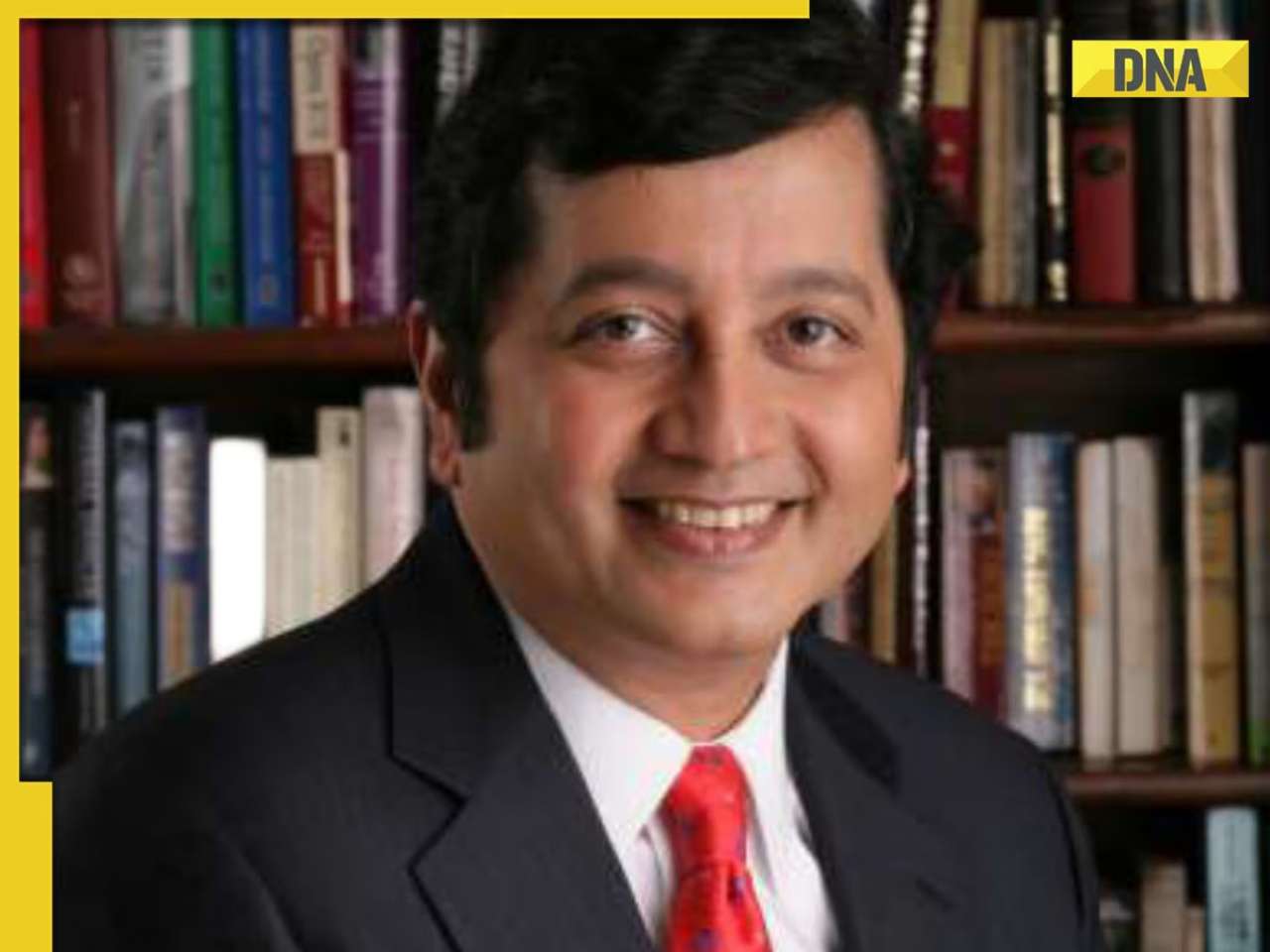Read on for insights on both from some of these leading lights of the architecture profession and key stakeholders of the real estate fraternity
This week, the DNA Sir J J Architecture Awards 2018 will honour the top alumni of Sir JJ College of Architecture, Mumbai, and the institution they passed out from at an exclusive, ‘By Invitation Only’ function. Read on for insights on both from some of these leading lights of the architecture profession and key stakeholders of the real estate fraternity
 Freedom and excitement to explore new horizons: Architect Sanjay Mohe
Freedom and excitement to explore new horizons: Architect Sanjay Mohe
I studied in a Marathi medium school which had a strict discipline. Coming to JJ was a big change for me. Suddenly there was freedom and excitement to explore new horizons. I still remember my first day at JJ and when I look back, those five years feel like a very long time compared to rest of the years because we were learning something new every day and that became a data bank for the rest of my life. We were connected with an art school, and seeing so much creativity around; students sitting on lawns, under trees and sketching; painting, sculpting was amazing. JJ did not have any established philosophy or influence of a particular master. In a way it gave you a chance to search and explore without getting influenced by a particular way of thinking. It was a lot of fun as well as hard work; we enjoyed every bit of it. It was not only about teaching but also about inspiring students. Sometimes a single teacher or a senior student or a single lecture can change your way of thinking, to make you passionate about architecture. That is what happened at JJ. And once you are passionate, you don’t stop learning throughout your life. Soon you realize that it is not only about the talent but it is about the attitude, about hard work.
Architecture for us is about creating spaces which are unique in its ‘feel’, providing its inhabitant a series of experiences through time and space, light and darkness, unfolding layers and volumes. We strongly believe in working in tandem with the five elements of nature and create spaces to sensitize our five senses by making nature as a part of built environment to elevate the experience of end users. We try to create equilibrium between man, his needs, emotions, culture, his aspirations, elements of nature and the technological advancement.
Our studio is involved in creating projects that are an amalgam of the latest global practices, technological advancements and local influences. Spaces created are unique in its ‘feel’ where ‘experience’ takes precedence over ‘form’. Majority of our projects are institutions, large scale residential development, research labs and offices.
Designing a school or an institution is always exciting and challenging since it is about dealing with the energy of children of different age groups, from nursery kids to adolescent teens. The school is a fortress of learning that needs to be challenged and conceptualised more as a resource- rich learning centre that supplements lifelong learning. It is important to create a sustainable environment linking indoor and outdoor places. We have tried to integrate contemporary architectural styles into the Indian educational culture which symbolises “learning under a tree”. Classrooms being the most important part of the school became pavilions of knowledge where a healthy dialogue can be initiated. Nature becomes an integral part of the classrooms in the form of courtyards. The classrooms are as open as they can possibly be – no walls and bounded by green courtyards on either side permits unobstructed flow of breeze and brings in glare free natural light. (Refer to Sreenidhi International school Classroom, Care College Trichy).
 Turning point of my life: Architect Prem Nath
Turning point of my life: Architect Prem Nath
I feel privileged to be an alumnus of Sir J.J. College of Architecture. The college has not just been the foundation of my career, but also a turning point in life.
Upon enrolling myself to Sir J. J. College of Architecture, I learned quite a few lessons of life – unlike my classmates who hailed from rich and affluent families, I was a poor boy who lived a life below par than most of my classmates.
I was a quiet student in class but I worked hard to stay ahead in class. Soon my teachers and my fellow classmates started noticing my brilliant work and my drawings were showcased in the college hall during events. I thought to myself, in order to converse well I had to groom myself. Thus I spent most of my free time in the college library reading books and bettering my language skills. Thus by overcoming my shortcomings and excelling in every stage of my life, I passed my final year of Architecture with Top Honours.
I strive to give back to my alma mater Sir J.J. College of architecture through AAJJA (Alumni Association of Sir J.J. College of Architecture).
My design philosophy is to keep it simple and smart – I want my designs to be very functional – I strongly believe that the designs which have a lot of acrobatics always end up not living the test of time – while simple designs and forms are always liked by all strata and types of people.
I have always been establishing a lot many innovations myself – as an architect, I have many firsts to my credit, be it the first ever Revolving Restaurant – Ambassador Hotel, Mumbai; India’s first ever Health Spa & Body Rejuvenation Centre that was designed for World Resorts Ltd, at Golden Palm Resorts, Bangalore; the first multiplex-mall in the country i.e. Fame Adlabs at Citimall, Andheri Mumbai, which is a trendsetter for all other multiplexes to follow; the country’s first fast-track I.T. building that was designed, executed and handed over to Morgan & Stanley of USA, in just an eight month period from the date of first client meeting to handover; the first Semiconductor Plant i.e. Meltron Semiconductors Ltd at Nashik, a Indo-French collaboration; India’s first Gold graded Township for HP-Mittal Energy Limited in Punjab; India’s first Platinum rated School – Cygnus world school at Vadodara, Gujarat; and various other smart projects with an emphasis on sustainable and liveable developments such as the Smart Tower in GIFT City.
 Environment conscience: Architect Brinda Somaya
Environment conscience: Architect Brinda Somaya
The architect’s role is that of a guardian. He or she is the conscience of the built and unbuilt environment. Architecture, for me, is about connecting and creating spaces between the earth and man.
 Innovative approach: Architect Kishore D. Pradhan
Innovative approach: Architect Kishore D. Pradhan
During my student days, Sir J.J. College of Architecture already had an iconic status in India. You felt proud even when you just got an admission in the college. Subsequently, the feeling of pride gave way to humility due to the knowledgeable teachers, members of the core as well as the visiting faculty. Their personalities were awe-inspiring due to their knowledge and professional status. All this made us put in a lot of hard work and aspire to attain a high level of proficiency as that of role models.
As a practicing professional, I always wanted to leave a mark of excellence. You can call that as my USP. This led to me formulating designs that would be truly functional and with optimum project expenditure.
All my projects were designed with an innovative approach to achieve the goals with utmost sincerity. The design solutions were successfully implemented against all the site-related hurdles with sincere efforts towards functional fulfilment, environmental harmony and tight control on project costs. There was no scope for gratuitous extravagance and even a smallest dot in my drawings has been purposeful, not to be taken lightly.
That my professional attitude and talent was appreciated is evident by the big list of the loyal clients with whom I have worked repeatedly since more than forty years.
 Structures and spaces: Architect Prof. Aban Zarir Sethna
Structures and spaces: Architect Prof. Aban Zarir Sethna
Architecture, by itself, is too technical a subject. It needs to be rounded off by the study of humanities. Structures and spaces shaped by man cannot be torn from their cultural matrix. On the other hand, architects as designers, cannot operate in a socio-cultural vacuum. They need to be socially-aware and committed to serving society. This briefly is justification for the study of humanities.
 Students into leaders: Architect Chandrashekhar Prabhu
Students into leaders: Architect Chandrashekhar Prabhu
Sir JJ converted me from a student into a leader with all round qualities. My USP is that I dedicate my efforts to the well-being of the public at large. My architectural philosophy is that the cities and buildings within must address themselves to the hopes and aspirations of the people.
The entire movement of self-redevelopment has been founded and led by me. The movement has been one of the greatest success stories in modern India.
 A competitive learning environment that inspired me to excel: Architect Niteen Parulekar
A competitive learning environment that inspired me to excel: Architect Niteen Parulekar
Sir J.J. College of Architecture has a competitive learning environment. This has inspired me to excel in the field of Architecture and Design. Design that touches human aspiration appeals to all; rest is math and geometry.
In 1996, I founded NPAPL, a design studio which can design and assist its clients during the project executions by way of project management, cost management and liasoning. This was one way of ensuring that justice is done to meticulous and detailed design development process. Interior designing has been integral to NPAPL and also one of the first disciplines wherein NPAPL provided design and build services to its clients as early as in 1996. Over the years, NPAPL has evolved into an organisation that can add value at each and every phase of project development.
However, the journey of NPAPL began even before it was incorporated in 1996. The genesis of this design studio lies way back in 1988 when I commenced work as a professional architect after completing the degree from the renowned Sir J. J. School of Architecture.
As an entrepreneur, I envisaged the need of a creative strategic design studio – NPAPL, which can act like a partner to its clients by undertaking various roles during the entire project development cycle. I also believed in creating landmarks that would appeal aesthetically to one and all, which in turn would dominate landscapes of urban centres. This has been the principal on which NPAPL was founded.
For an architect, his name is a brand that can assure his clients about the project delivery to their satisfaction. An architect through his designs creates lasting impressions for his clients and for the society. Today, Niteen Parulekar is one such name and a brand that has come to be associated with passionate designs and exceptionally relevant interior build solutions. For over 20 years, I have delivered designs that have become landmarks, which have been functionally efficient for my clients and have won me many accolades.
My style of architecture is supported by my vision to appeal to the human aspiration and an appetite for innovation. My designs have been bold and reflect creative brilliance. However, the most important characteristic that has enabled me to stay relevant to this dynamic marketplace is my entrepreneurial instinct. I have performed various roles during project execution; however the primary objective has been to remain a trusted partner for clients, ensuring successful completion of the projects.
NPAPL has backward integrated to take up the comprehensive consultancy assignments and forward integrated to set up in-house departments for procurement, construction management and other services. Today NPAPL has successfully completed more than 450 projects which would approximately admeasure 145 million sq ft and has handled projects as big as six million sq ft. It has catered to residential, commercial, hospitality, industrial, institutional projects. However, this is just one of the milestones for NPAPL which is poised to leap into a new growth trajectory through a robust expansion plan.
Throughout its history, NPAPL has passionately adhered to its core values of creativity, transparency and integrity. This has enabled NPAPL to become a trusted partner for its clients, winning their trust and along the way acquiring repeat business. As of today, NPAPL has worked with varied types of projects, impressing its presence across India. Every individual who has worked with NPAPL and some who have been with NPAPL since its incorporation have adhered to these founding principals in spirit. With such a motivated workforce, NPAPL has supported this endeavour of creating landmarks, in earnest and have conceptualised some of the most famous buildings in the country that are aesthetically appealing and have served their functional purpose to fullest. Knowledge creation and sharing which forms an integral part of NPAPL’s working culture resulted in a repository of creative ideas which supports design development process.
Over these years, NPAPL has gone through business transformations, adjusting its strategic intent so as to stay relevant to the marketplace. Today, NPAPL offers various services under one roof including design and engineering, MEP and HVAC consultancy, interior design and build, project management consultancy, procurement and cost-analysis consultancy, liasoning and approvals. One of the strong points of this delivery model is the in-house teams set up for expediting services offered. Be it the design development department which is the nucleus of creativity or the 3D visualisation department creating flawlessly real renderings, presence of in-house experts has enabled rapid project executions with additional benefit of value engineering. This has ultimately resulted in higher quality at optimised costs for the clients. NPAPL’s strength remains in the optimum mix of passionate designs and technical knowledge, which has enabled it to achieve “Creative Brilliance”.
 An ultimate space to be in for being an architect: Architect Shakti Parmar
An ultimate space to be in for being an architect: Architect Shakti Parmar
It was in school when I read the book “The Fountainhead” by Ayn Rand. I was very involved in writing poetry and plays and also acting on the stage, and with that background I just wanted to be an architect. During those times J. J.College of Architecture was an ultimate space to be in for being an architect, and with that experience being a part of it. It actually and most naturally happed to me with the environment in the campus and interaction between the seniors, juniors and the involved faculties. J. J. has the richest and architecturally involved past which is unparalleled.
Being an architect in the duration of transmittance has been and is the most natural thing for those who choose to be in this campus. Commercial art, fine art and school for sculptors which also has a rich deep history for being a part of J. J. campus make it a learning experience for an architect.
I do not have a set philosophy for design; my work is born from deep within, with immense love for mother earth, the nature and the beautiful people. I design space for the people and with the people.
It is unfortunate what we built in the last 100 plus years. I would like to have the space designed for today as we need, tomorrow that we may only partially belong to, but certainly not their tomorrow, which will be left for the next generation to take care of (today and tomorrow). I do not believe in monument and don’t want to force unchangeable architecture on mother earth.
Innovation in working in architecture happens effortlessly, at least in my work. It’s for the people who are part of those spaces or the environment to experience the happening around.
 Refined views on design: Architect Shirish Sukhatme
Refined views on design: Architect Shirish Sukhatme
Those were the days where Auto CAD, Corel Draw, Photoshop was nonexistent. Manual drafting, Rotring pens, pencils, T Squares, Set Squares were the only tools for an architect. In the year 1971 the admission in JJ College of Architecture was after 11th standard and my B Grade in Intermediate Exam and 74% marks (those days) put me on the seventh rank on the merit for admission. JJ was the only college giving a degree in Architecture in Mumbai. Our professors like Prof. Tembekar, Prof. Parasnis, Prof. Gatne, Prof. Mohan Godbole, Prof. Mulik, Prof. Kudalkar and Prof. Sethna were amongst the few professors who built our foundation as architects. Prof. Dr. Muni Chakraborty was one of the eminent faculties in IIT Kharagpur who refined my views about design process.
Function, activity and comfort are guiding forces and blending of aesthetics with function is quintessential and a challenge for architect with minimum compromise.
NOTEWORTHY CONCEPTS IN PROJECTS
TRAUMA CARE HOSPITAL AT JOGESHWARI
Accommodating 325 beds, it is an efficient design solution with maximum intervention due to various services like hospital gases, HVAC, fire fighting, electrical systems, EPBX, nurses call system and fire alarm system. The hospital is serving poor citizens of Mumbai.
OCTROI NAKA AT MULUND
This is prize winning entry, and popular for efficient traffic co-ordinating solution on the Eastern Express Highway. This newly constructed Octroi Naka has solved the issue of perpetual traffic jam of Eastern gate of Mumbai from Thane.
Architecture Philosophy: Function, activity and comfort are guiding forces and blending of aesthetics with function is quintessential.
 Learning to develop project vision: Architect Uday Athavankar
Learning to develop project vision: Architect Uday Athavankar
Architecture defined the way I think, live and the choice of the object that I surround myself with. J. J. laid the foundation for this passion. So many people were involved in this process. These include my classmates, the J. J. community and the classroom interaction with teachers and fellow students. What influenced me was seeing what others have done and listening to the teachers commenting on students’ work. This friendship group is still intact and even now we continue to discuss architecture and built forms. To capture it quickly, J. J. gave me the purpose of my life.
The greatest asset of J. J. is the library. It introduced me to the work of great masters. Books, like “The Fountainhead”, gave me role models to look up to and encouraged me to develop my own dreams to change the world of objects and built spaces. My much loved books were the Master Builder series, which was based on my role models.
In J. J., I learnt to develop my project vision and my dreams of built-forms before I draw my first line on paper. Lastly, it gave me an area of my interest, affordable housing, that I continue to work on.
I consider myself lucky that I had opportunities to wear three hats. I learnt to seamlessly mix my roles as a designer, as a researcher and as a teacher. I learn from one role and use it in the other roles. All my commercial projects feed my research and teaching case studies and vice versa. So, I learnt to practice what I teach, and teach what I have practiced.
I moved on from architecture to industrial design and game design to product planning and business models and that too with different project assignment. I learnt at the cost of my clients. Each area informed the other area. For instance, I used business model and game design backgrounds to create master plan and affordable housing.
I realised that design as a profession has remained practice oriented. As a result, the knowledge base on which the profession is built has not developed rapidly. That is why a lot of people reduce the design activity to a level of common sense. So, a substantial part of my time is spent on serious design research. This has resulted in over fifty research papers published internationally. I am now consolidating them into three books through my blog, so that the knowledge is easily accessible to students.
Tech based projects: A large number of my projects are in industrial design and game design. Most of them are tech based projects. These were always informed by my research.
- Gamma chamber: A science lab product, it is designed to give pre-calculated and controlled radioactive doses to samples. As a precautionary measure, the control panel is duplicated so that the equipment can also be operated from a neighbouring room.
- Low cost ATM: With minimal changes a new identity had to be created for a functional looking low cost ATM. We increased the usability and added a number of features like, privacy wings as well as designed space for branding etc. The low cost ATM for NCR fetched the team an award for its design from the President of India. The product was made in China and marketed there as well as in India.
- Night vision monocular: The product uses contrast-enhancing CCD to help people with very low vision capabilities to see objects. Expecting that people may not like others to know their handicap, the design used the metaphor of photography devices to camouflage its identity. The estimated requirements were so low, that the challenge was to find production methods that could give precision and yet be produced in low quantities.
Cultural products
- Indicasan: This explores effectiveness of inclined seat to support Indian squatting posture, without any previous practice. The seat inclination ensures that the spinal cord remains vertical. Visually, it assimilates the western work chair typology with Indian sitting and visual language.
- Temple: The new design displays interpretation of traditional temple features constructed with modernist structure with flat large stone surfaces, not so common in the tradition of temples.
- Jewellery showcase: Show window for jewellery showroom was designed by my friend, also a J. J. colleague. It deliberately creates a mix of post-modernist aesthetics with Indian jewellery tradition and visual language.
Games: Rural Development game won a design award in the international game design competition.
 Practical knowledge: Architect Rusi Khambatta
Practical knowledge: Architect Rusi Khambatta
At the time of my education (1945) at Sir J J School of Architecture, the total set-up was different from the present. The education was imparted by visiting staff members who had practices of their own. Hence, the education was more oriented with less academic knowledge and more with what is acceptable in practice. Architecture has travelled a long distance since then. The triple context of ‘geographical, social and economics’ is now extended with ‘ecology’ – a factor most important for consideration, in our present days of catastrophic ‘climate change’, a factor which in turn affects our daily life with disastrous results. Its chief contributor is production of energy. Buildings which consume nearly 30% of energy is a major culprit in this cycle of change and hence we architects owe a great responsibility by planning to consume a minimum of energy by taking maximum advantage of Gods’ given gift of natural resources by way of breeze, sun light and all such other extraneous factors and thus lessen the use of conventional source means of energy. These concerns have been answered in my Guwahati project.
 The perfect ambience: Architect Gurunath Dalvi
The perfect ambience: Architect Gurunath Dalvi
“The art of conceiving and creating beautiful, happy, comfortable spaces for the mankind to live in, with enhanced quality of life” is what I believe in. The rustic black stone edifice of the college building, standing majestically amongst the vast green expanse of the campus, provided the perfect ambience that was conducive not only for learning and to pursue academic success that one would normally intend to achieve at the end of it; but for me it was the most rightful place where i could explore and hone the hitherto dormant talents lying in me, in extra-curricular areas like dramatics, music, oratory etc. It was to my advantage to have very learned, experienced and most dedicated professors who left no stone unturned for overall development of students. The attitude of then professors tempted me to enter in to the field of education and gave me an opportunity to produce thousand of architects during last 50 years. I firmly believe that my association with Sir J. J. College contributed great deal toward holistically building up my professional and social career in later days.
INDUSTRY PERSPECTIVES
 With time, everything goes through a transition, to become adaptable and to fit into the shifting paradigm, as per the need of the hour. Architecture is no different; from creating beautiful monumental buildings with traditional roots to now prevalent minimalistic and environment friendly structures, it has come a long way. As India is demographically moving from smaller cities to bigger cities; the focus now is to utilise that limited space in the most optimum way possible, ensure green living, natural lighting and open breathing spaces. Hence, architecture has become more relevant than it has ever been in the history of humanity.
With time, everything goes through a transition, to become adaptable and to fit into the shifting paradigm, as per the need of the hour. Architecture is no different; from creating beautiful monumental buildings with traditional roots to now prevalent minimalistic and environment friendly structures, it has come a long way. As India is demographically moving from smaller cities to bigger cities; the focus now is to utilise that limited space in the most optimum way possible, ensure green living, natural lighting and open breathing spaces. Hence, architecture has become more relevant than it has ever been in the history of humanity.
Alumni of Sir JJ College of Architecture have had an illustrious history in breaking the path and transforming the world of architecture - Padma Shri B.V. Doshi, a notable architect; most famous for his contribution to the creation of IIM Bangalore, Padma Shri Late Achyut Purushottam Kanvinde, who worked in functionalist approaches with elements of Brutalist architecture. Their revolutionary approach, influences and hard work gave India and its architects a new direction to follow. Given the rigour of the curriculum and the illustrious past of institute’s alumni, I think the future is worth looking for.
Peeyush Bachlaus, Head – Marketing, Kansai Nerolac Paints Ltd.
 Architecture, from time immemorial, has been associated with the context of human race evolution and continues to be of much more consequence today, when emerging trends for a sustainable future beckons designing buildings that evolve sound economic, environmental and smart ‘new-age’ human-impact decisions.
Architecture, from time immemorial, has been associated with the context of human race evolution and continues to be of much more consequence today, when emerging trends for a sustainable future beckons designing buildings that evolve sound economic, environmental and smart ‘new-age’ human-impact decisions.
Mohit Hajela, Group Head - Business Development, Jaquar Group
![submenu-img]() BMW i5 M60 xDrive launched in India, all-electric sedan priced at Rs 11950000
BMW i5 M60 xDrive launched in India, all-electric sedan priced at Rs 11950000![submenu-img]() This superstar was arrested several times by age 17, thrown out of home, once had just Rs 250, now worth Rs 6600 crore
This superstar was arrested several times by age 17, thrown out of home, once had just Rs 250, now worth Rs 6600 crore![submenu-img]() Meet Reliance’s highest paid employee, gets over Rs 240000000 salary, he is Mukesh Ambani’s…
Meet Reliance’s highest paid employee, gets over Rs 240000000 salary, he is Mukesh Ambani’s… ![submenu-img]() Meet lesser-known relative of Mukesh Ambani, Anil Ambani, has worked with BCCI, he is married to...
Meet lesser-known relative of Mukesh Ambani, Anil Ambani, has worked with BCCI, he is married to...![submenu-img]() Made in just Rs 95,000, this film was a superhit, but destroyed lead actress' career, saw controversy over bold scenes
Made in just Rs 95,000, this film was a superhit, but destroyed lead actress' career, saw controversy over bold scenes![submenu-img]() DNA Verified: Is CAA an anti-Muslim law? Centre terms news report as 'misleading'
DNA Verified: Is CAA an anti-Muslim law? Centre terms news report as 'misleading'![submenu-img]() DNA Verified: Lok Sabha Elections 2024 to be held on April 19? Know truth behind viral message
DNA Verified: Lok Sabha Elections 2024 to be held on April 19? Know truth behind viral message![submenu-img]() DNA Verified: Modi govt giving students free laptops under 'One Student One Laptop' scheme? Know truth here
DNA Verified: Modi govt giving students free laptops under 'One Student One Laptop' scheme? Know truth here![submenu-img]() DNA Verified: Shah Rukh Khan denies reports of his role in release of India's naval officers from Qatar
DNA Verified: Shah Rukh Khan denies reports of his role in release of India's naval officers from Qatar![submenu-img]() DNA Verified: Is govt providing Rs 1.6 lakh benefit to girls under PM Ladli Laxmi Yojana? Know truth
DNA Verified: Is govt providing Rs 1.6 lakh benefit to girls under PM Ladli Laxmi Yojana? Know truth![submenu-img]() In pics: Arti Singh stuns in red lehenga as she ties the knot with beau Dipak Chauhan in dreamy wedding
In pics: Arti Singh stuns in red lehenga as she ties the knot with beau Dipak Chauhan in dreamy wedding![submenu-img]() Actors who died due to cosmetic surgeries
Actors who died due to cosmetic surgeries![submenu-img]() See inside pics: Malayalam star Aparna Das' dreamy wedding with Manjummel Boys actor Deepak Parambol
See inside pics: Malayalam star Aparna Das' dreamy wedding with Manjummel Boys actor Deepak Parambol ![submenu-img]() In pics: Salman Khan, Alia Bhatt, Rekha, Neetu Kapoor attend grand premiere of Sanjay Leela Bhansali's Heeramandi
In pics: Salman Khan, Alia Bhatt, Rekha, Neetu Kapoor attend grand premiere of Sanjay Leela Bhansali's Heeramandi![submenu-img]() Streaming This Week: Crakk, Tillu Square, Ranneeti, Dil Dosti Dilemma, latest OTT releases to binge-watch
Streaming This Week: Crakk, Tillu Square, Ranneeti, Dil Dosti Dilemma, latest OTT releases to binge-watch![submenu-img]() What is inheritance tax?
What is inheritance tax?![submenu-img]() DNA Explainer: What is cloud seeding which is blamed for wreaking havoc in Dubai?
DNA Explainer: What is cloud seeding which is blamed for wreaking havoc in Dubai?![submenu-img]() DNA Explainer: What is Israel's Arrow-3 defence system used to intercept Iran's missile attack?
DNA Explainer: What is Israel's Arrow-3 defence system used to intercept Iran's missile attack?![submenu-img]() DNA Explainer: How Iranian projectiles failed to breach iron-clad Israeli air defence
DNA Explainer: How Iranian projectiles failed to breach iron-clad Israeli air defence![submenu-img]() DNA Explainer: What is India's stand amid Iran-Israel conflict?
DNA Explainer: What is India's stand amid Iran-Israel conflict?![submenu-img]() This superstar was arrested several times by age 17, thrown out of home, once had just Rs 250, now worth Rs 6600 crore
This superstar was arrested several times by age 17, thrown out of home, once had just Rs 250, now worth Rs 6600 crore![submenu-img]() Made in just Rs 95,000, this film was a superhit, but destroyed lead actress' career, saw controversy over bold scenes
Made in just Rs 95,000, this film was a superhit, but destroyed lead actress' career, saw controversy over bold scenes![submenu-img]() Meet 72-year-old who earns Rs 280 cr per film, Asia's highest-paid actor, bigger than Shah Rukh, Salman, Akshay, Prabhas
Meet 72-year-old who earns Rs 280 cr per film, Asia's highest-paid actor, bigger than Shah Rukh, Salman, Akshay, Prabhas![submenu-img]() This star, who once lived in chawl, worked as tailor, later gave four Rs 200-crore films; he's now worth...
This star, who once lived in chawl, worked as tailor, later gave four Rs 200-crore films; he's now worth...![submenu-img]() Tamil star Prasanna reveals why he chose series Ranneeti for Hindi debut: 'Getting into Bollywood is not...'
Tamil star Prasanna reveals why he chose series Ranneeti for Hindi debut: 'Getting into Bollywood is not...'![submenu-img]() IPL 2024: Virat Kohli, Rajat Patidar fifties and disciplined bowling help RCB beat Sunrisers Hyderabad by 35 runs
IPL 2024: Virat Kohli, Rajat Patidar fifties and disciplined bowling help RCB beat Sunrisers Hyderabad by 35 runs![submenu-img]() 'This is the problem in India...': Wasim Akram's blunt take on fans booing Mumbai Indians skipper Hardik Pandya
'This is the problem in India...': Wasim Akram's blunt take on fans booing Mumbai Indians skipper Hardik Pandya![submenu-img]() KKR vs PBKS, IPL 2024: Predicted playing XI, live streaming details, weather and pitch report
KKR vs PBKS, IPL 2024: Predicted playing XI, live streaming details, weather and pitch report![submenu-img]() KKR vs PBKS IPL 2024 Dream11 prediction: Fantasy cricket tips for Kolkata Knight Riders vs Punjab Kings
KKR vs PBKS IPL 2024 Dream11 prediction: Fantasy cricket tips for Kolkata Knight Riders vs Punjab Kings![submenu-img]() IPL 2024: KKR star Rinku Singh finally gets another bat from Virat Kohli after breaking previous one - Watch
IPL 2024: KKR star Rinku Singh finally gets another bat from Virat Kohli after breaking previous one - Watch![submenu-img]() Viral video: Teacher's cute way to capture happy student faces melts internet, watch
Viral video: Teacher's cute way to capture happy student faces melts internet, watch![submenu-img]() Woman attends online meeting on scooter while stuck in traffic, video goes viral
Woman attends online meeting on scooter while stuck in traffic, video goes viral![submenu-img]() Viral video: Pilot proposes to flight attendant girlfriend before takeoff, internet hearts it
Viral video: Pilot proposes to flight attendant girlfriend before takeoff, internet hearts it![submenu-img]() Pakistani teen receives life-saving heart transplant from Indian donor, details here
Pakistani teen receives life-saving heart transplant from Indian donor, details here![submenu-img]() Viral video: Truck driver's innovative solution to beat the heat impresses internet, watch
Viral video: Truck driver's innovative solution to beat the heat impresses internet, watch







































)
) Freedom and excitement to explore new horizons: Architect Sanjay Mohe
Freedom and excitement to explore new horizons: Architect Sanjay Mohe) Turning point of my life: Architect Prem Nath
Turning point of my life: Architect Prem Nath) Environment conscience: Architect Brinda Somaya
Environment conscience: Architect Brinda Somaya) Innovative approach: Architect Kishore D. Pradhan
Innovative approach: Architect Kishore D. Pradhan) Structures and spaces: Architect Prof. Aban Zarir Sethna
Structures and spaces: Architect Prof. Aban Zarir Sethna) Students into leaders: Architect Chandrashekhar Prabhu
Students into leaders: Architect Chandrashekhar Prabhu) A competitive learning environment that inspired me to excel: Architect Niteen Parulekar
A competitive learning environment that inspired me to excel: Architect Niteen Parulekar) An ultimate space to be in for being an architect: Architect Shakti Parmar
An ultimate space to be in for being an architect: Architect Shakti Parmar) Refined views on design: Architect Shirish Sukhatme
Refined views on design: Architect Shirish Sukhatme) Learning to develop project vision: Architect Uday Athavankar
Learning to develop project vision: Architect Uday Athavankar) Practical knowledge: Architect Rusi Khambatta
Practical knowledge: Architect Rusi Khambatta) The perfect ambience: Architect Gurunath Dalvi
The perfect ambience: Architect Gurunath Dalvi) With time, everything goes through a transition, to become adaptable and to fit into the shifting paradigm, as per the need of the hour. Architecture is no different; from creating beautiful monumental buildings with traditional roots to now prevalent minimalistic and environment friendly structures, it has come a long way. As India is demographically moving from smaller cities to bigger cities; the focus now is to utilise that limited space in the most optimum way possible, ensure green living, natural lighting and open breathing spaces. Hence, architecture has become more relevant than it has ever been in the history of humanity.
With time, everything goes through a transition, to become adaptable and to fit into the shifting paradigm, as per the need of the hour. Architecture is no different; from creating beautiful monumental buildings with traditional roots to now prevalent minimalistic and environment friendly structures, it has come a long way. As India is demographically moving from smaller cities to bigger cities; the focus now is to utilise that limited space in the most optimum way possible, ensure green living, natural lighting and open breathing spaces. Hence, architecture has become more relevant than it has ever been in the history of humanity.) Architecture, from time immemorial, has been associated with the context of human race evolution and continues to be of much more consequence today, when emerging trends for a sustainable future beckons designing buildings that evolve sound economic, environmental and smart ‘new-age’ human-impact decisions.
Architecture, from time immemorial, has been associated with the context of human race evolution and continues to be of much more consequence today, when emerging trends for a sustainable future beckons designing buildings that evolve sound economic, environmental and smart ‘new-age’ human-impact decisions.



)
)
)
)
)
)